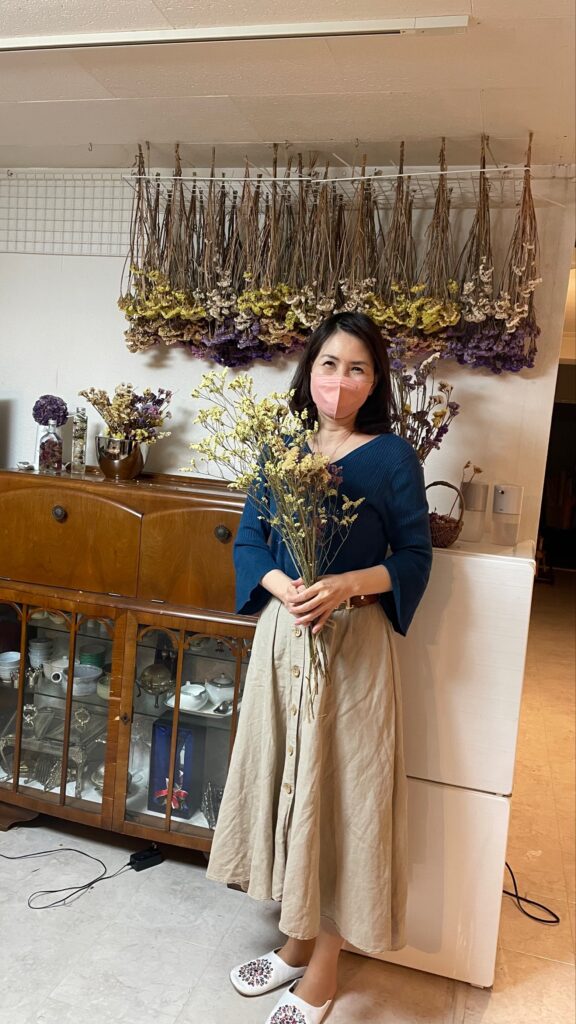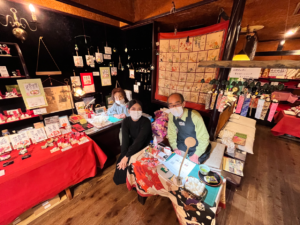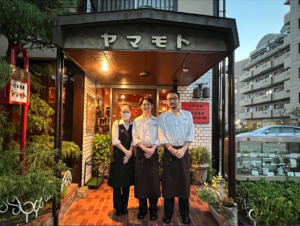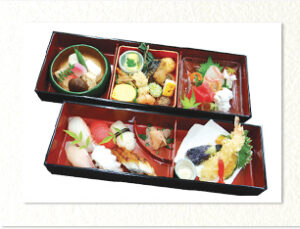Interviewers/Authors: Kotaro Teshima, Yukina Yoshioka
Ms. Eiko Hamasaki is the representative of the Institute for the Psychological Study of Human Flower Relations and the Flower Psychology Association, a non-profit organization. She practices flower therapy, which combines flower arrangement (ikebana) and psychology. She established the Japan Ikebana Therapy Society and conducts online courses for training ikebana therapists. Furthermore, as a licensed psychologist (national certification), she provides psychological support to students with developmental problems at the Kyoto Prefecture Single-parent Family Independence Support Center and after-school daycare.

―How did you get started with flower therapy?
Hamasaki: When I was a university student, I studied psychology on and off the campus while learning ikebana as a hobby, but at the time I still didn’t intend to merge the two. When I was depressed after becoming a single parent, I happened to have the opportunity to go to a flower exhibition. I was moved by a small flower blooming with dignity amid the magnificent ikebana works. That’s when I realized anew the power of flowers, and I thought that I could come up with good blend of ikebana and psychology. I also felt that I could create a place that would make up for the negativity I had felt toward general methods of psychological therapy.
―So, there were some links between ikebana and psychology for you, weren’t there?
Hamasaki: Even withered leaves or leaves eaten by insects can be used in works of art and they lead to the spirituality of ikebana. The essence of ikebana is to respect the life and individuality of a single flower and to recognize the existence value of each one. This same principle applies to human relationships, too.
―Why did you want to provide your distinctive flower therapy?
Hamasaki: When I decided to open this institute ten years ago, most flower therapies were based on stereotypes, such as “This flower should be for this person.” or “The person who uses a rose should be kind.” This was also the part that I was not satisfied with. I wanted to work on something different, so I developed a new type of flower therapy that could draw out each person’s story from various flowers which should have been so familiar to us.
―I heard that you received a doctorate, am I right?
Hamasaki: Earning a doctorate was one of my goals, so I worked so hard on it, cutting out all sorts of temptations (laughs). I wanted to research why flowers have the potential to heal because nobody had ever done it before. Our institute has presented at conferences and written papers as an institute so that we can provide evidence with a solid basis. We also have offered both practice and research opportunities because providing effective assistance to people cannot be done solely based on theory.
―What message do you want to keep sending to people through the activities you are carrying out?
Hamasaki: I’d like people to know that flowers are a tool that allows you to honor your individuality, recognize the value of both self and others, and find out your own role in society. Ikebana has lots of hidden clues that could contribute to making our society sustainable. Traditional Japanese culture such as calligraphy, the tea ceremony, and flower arrangement all have “mindfulness” at their core. Ikebana is often considered a hurdle for Japanese people even in our traditional culture, but for the above reasons, I’d like more people to experience it.
―You seem to be constantly busy and energetic.
Hamasaki: Well, I sometimes zone out and do nothing at home, though (laughs). Doing work from various positions in a day refreshes my mind. Nothing is better than being able to make what one likes a job. Also, engaging in supportive activities gives me a great deal of inspiration and makes every day a brand-new day so that I don’t feel tired all that much.
―How have you involved the local community through your flower therapy?
Hamasaki: Everyone has a role to play and something around them to work on, so we implement projects that are easy to work on, especially for the elderly and children. We have decorated the Ukyo Ward Office and the Saga-Toriimoto area with ikebana works made by all participants and have visited aging communities to decorate the streets with those works, and actively taken part in community festivals. Seeing that many of the participants have been able to go out on their own through our activities makes me happy and feel like contributing to the local community.
―Is there anything you would like to try in the future?
Hamasaki: I’d like to set up a flower shop where people with dementia or disabilities can work. Have you ever heard of the Restaurant of Mistaken Orders? That is one of my ideal styles. I’d also like to build a model of support for single-parent families. We’re already increasing the number of projects that families can attend to help them become independent with their children, but we’d like to further support the issue of time poverty and ensure that they can watch their children grow up.
―Could you leave a message for readers?
Hamasaki: Generating change requires the ability to involve more people, and I hope that the breadth of the network, which is one of the strengths of my institute, will supply some inspiration to you. Taking part in social activities is going to be hard for everyone at first, however, it is important to have the passion to try. If you make your own flower arrangement, please bring it to my office. We will display it with the works made by residents. I’m looking forward to seeing you someday.
Interviewer’s comments
I met Ms. Hamasaki on the day of the interview after she had completed her varied schedule, but when I talked to her, I got the impression that she was even tougher and lighter on her feet than I had thought. I was impressed that she tackled many projects based on her own experience. She was a friendly person with a big smile, so I felt people like her and naturally gather around her.
(Yukina Yoshioka)


![京都 春爛漫[4820]](http://ukyovoices.pya.jp/wordpress/wp-content/uploads/2023/01/6542e8aea0d7c4029269fb8d5f01f48b-300x200.jpg)






Comments